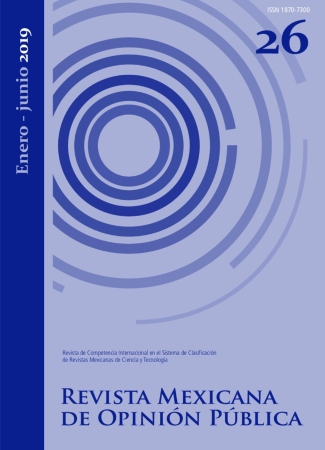Ideological Coherence of PJ and UCR in the Argentinean Congress (1996-2010)
Main Article Content
Abstract
This article attempts to study the ideological and programmatic coherence of PJ and UCR in the Argentinean Congress between 1996 and 2010. For that purpose, three dimensions ―ideological, programmatical-economical and programmatical-value― are developed to calculate an index of incoherence, in order to classify parties according to their level of incoherence in high, middle and low. According to the findings, ucr is more coherent than pj; there are differences between the parties, dimensions, and years studied; and the factors used by the literature do not always explain the variances of incoherence.
Article Details
Citas en Dimensions Service
References
ALCÁNTARA SÁEZ, Manuel, ¿Instituciones o máquinas ideológicas? Origen, programa y organización de los partidos políticos latinoamericanos, Institut de Ciències Polítiques y Socials, Barcelona, España, 2004.
ALCÁNTARA SÁEZ, Manuel y RIVAS, Cristina, “Las dimensiones de polarización partidista en América Latina”, Política y gobierno, vol. 14, núm. 2, Centro de Investigación y Docencia Económicas (CIDE), Ciudad de México, México, 2007, pp. 349-390.
ALTMAN, David, LUNA, Juan P., PIÑEIRO, Rafael y TORO, MAUREIRA Sergio, “Partidos y sistemas de partidos en América Latina: aproximaciones desde la encuesta a expertos 2009”, Revista de Ciencia Política, vol. 29, núm. 3, Pontificia Universidad Católica de Chile, Santiago de Chile, Chile, 2009, pp. 775-798. DOI: http://dx.doi.org/10.4067/S0718-090X2009000300005.
D’ALESSANDRO, Martín, “Las plataformas electorales en la Argentina moderna”, América Latina hoy, vol. 65, Instituto Iberoamérica-Universidad de Salamanca, Salamanca, España, 2013, pp. 107-139. DOI: http://dx.doi.org/10.14201/alh201365107139.
D’ALESSANDRO, Martín, “Political Advertising in Argentina”, en HOLTZ-BACHA, Christina y JUST R., Marion (eds.), Routledge Handbook of Political Advertising, Routledge, Nueva York, EE. UU., 2017, pp. 75-86.
GARCÍA, MONTERO, Mercedes y RUIZ RODRÍGUEZ, Leticia, “Coherencia partidista en las élites parlamentarias latinoamericanas”, Revista española de Ciencia Política, núm. 8, Asociación Española de Ciencia Política y de la Administración, Madrid, 2003, pp. 71-102.
Instituto de Iberoamérica, “Élites. Observatorio de élites parlamentarias en América Latina”., Universidad de Salamanca (USAL). Disponible en: <http://americo.usal.es/oir/elites/bases_de_datos.htm>, [fecha de consulta: 8 de diciembre, 2017].
KITSCHELT, Herbert, HAWKINS, Kirk, LUNA, Juan P., ROSAS, Guillermo y ZECHMEISTER, Elizabeth, Latin American Party Systems, Cambridge University Press, Nueva York, EE. UU., 2010.
LEIRAS, Marcelo, Todos los caballos del rey. La integración de los partidos políticos y el gobierno democrático de la Argentina, 1995-2003, Prometeo, Buenos Aires, Argentina, 2007.
MAINWARING, Scott y SCULLY, Timothy R., Building Democratic Institutions. Party Systems in Latin America, Stanford University Press, Stanford, EE. UU.,1995.
MUSTAPIC, Ana, BONVECCHI, Alejandro y ZELAZNIK, Javier (comps.), Los legisladores en el Congreso argentino, Instituto Torcuato Di Tella, Buenos Aires, Argentina, 2012.
OSTIGUY, Pierre, “Populism. A Socio-Cultural Approach”, en ROVIRA KALTWASSER, Cristobal, TAGGART, Paul, OCHOA ESPEJO, Paulina y OSTIGUY, Pierre (eds.), The Oxford Handbook of Populism, Oxford University Press, Oxford, Reino Unido, 2017, pp. 73-97.
RUIZ RODRÍGUEZ, Leticia y OTERO FELIPE, Patricia, “Indicadores para el estudio de los partidos políticos”, en Indicadores de partidos y sistemas de partidos, Centro de Investigaciones Sociológicas, Madrid, España, 2013, pp. 46-47.
RUIZ RODRÍGUEZ, Leticia, “Coherencia partidista: la estructuración interna de los partidos políticos en América Latina”, Revista Española de Ciencia Política, núm. 14, Asociación Española de Ciencia Política y de la Administración (AECPA), Madrid, España, 2006, pp. 87-114.
SAIEGH, Sebastián, “Recovering a Basic Space from Elite Surveys: Evidence from Latin America”, Legislative Studies Quarterly, vol. 34, núm. 1, Wiley, San Luis, Washington, EE. UU., 2009, pp. 117-146. DOI: https://doi.org/10.3162/036298009787500349.

Revista Mexicana de Opinión Pública por Universidad Nacional Autónoma de México se distribuye bajo una Licencia Creative Commons Atribución-NoComercial-SinDerivar 4.0 Internacional.
Basada en una obra en http://revistas.unam.mx/index.php/rmop.
